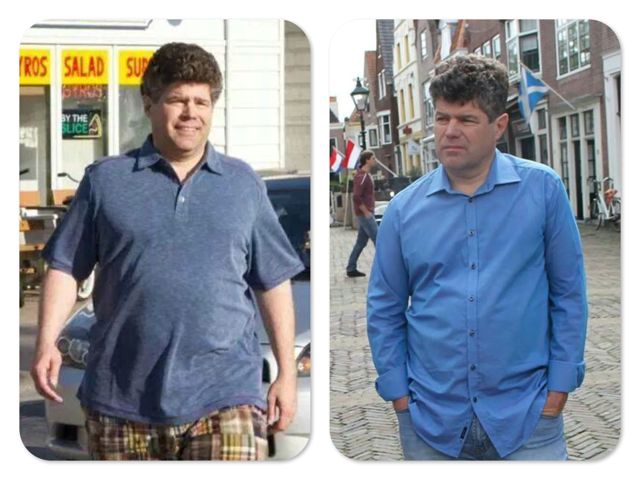By John Y. Brown III, on Fri Aug 29, 2014 at 12:00 PM ET Here is my “Before” alongside my future “After” pic.
About 6 months from now….while thinking about how much better I look with all that weight off, especially when I stand on a rock and look out over the ocean while wearing faded torn jeans with a tan and long hair with the wind blowing through it and a stylish watch in case I want to know what time it is.

Serious before and after:

By Julie Rath, on Fri Aug 29, 2014 at 8:30 AM ET 
Not ready to go as itty bitty as Burt Lancaster in The Swimmer? Even if you aren’t swimming home through the posh pools of suburbia, you should still do everything in your power to look your best when hitting the beach or pool. (And no, those ballooning board shorts don’t cut it.)
Below are my tips on what to look for in a well-fitting swimsuit, and my all-time favorite brand and style:
1) Trim leg openings make very slim legs look less so, and broad legs more proportioned.
Read the rest of…
Julie Rath: How to Turn Heads at the Beach
By John Y. Brown III, on Thu Aug 28, 2014 at 12:00 PM ET  My advice to young people entering the workforce. My advice to young people entering the workforce.
Don’t be intimidated. The competition is long on resume and first impression but short on practical usefulness and follow through.
If you can write and speak in complete sentences, respond to emails and phone calls within 24 hours, be courteous and appropriate, show up for work on time and don’t leave until you are supposed to and do all these things for three consecutive weeks and then keep doing them daily after that, you will be in the 98th% percentile and have a long and promising future in the work world.
Be patient with yourself –and with your colleagues. You have what it takes. Just do what is in front of you consistently and conscientiously and you’ll be fine. In fact, you will be extraordinary.
By Josh Bowen, on Thu Aug 28, 2014 at 8:30 AM ET  Of all the types of questions a fitness professional is asked, nutrition is the most common subject. Quite frankly people are clueless when it comes to what they eat. Conversely, that is not their fault. In this country we search for the quick fix, the easy way out and our media has done a great marketing job on “diets.” These diets usually consist of restriction some selection of food; fat, carbs, meat etc. So we are constantly told what we “shouldn’t” eat and rarely are we told what we should eat. So I wanted to put together a list of 10 foods that most everyone needs (barring food allergy, religious reasoning or preference). These 10 foods have various purposes that go beyond how many calories they consist of. These foods help the body ward off disease, decrease inflammation, and add vital vitamins and minerals to our body. Of all the types of questions a fitness professional is asked, nutrition is the most common subject. Quite frankly people are clueless when it comes to what they eat. Conversely, that is not their fault. In this country we search for the quick fix, the easy way out and our media has done a great marketing job on “diets.” These diets usually consist of restriction some selection of food; fat, carbs, meat etc. So we are constantly told what we “shouldn’t” eat and rarely are we told what we should eat. So I wanted to put together a list of 10 foods that most everyone needs (barring food allergy, religious reasoning or preference). These 10 foods have various purposes that go beyond how many calories they consist of. These foods help the body ward off disease, decrease inflammation, and add vital vitamins and minerals to our body.
1. Eggs- Eggs are on this list for a variety of reasons; the whites are full of high biological value protein (that is a good thing), the yellow is full of leptin (which controls appetite) and they are extremely versatile (scrambled, poached, boiled etc.). Eggs also have 12 vitamin and minerals, one of which (choline) is vital for brain development and increased memory. Eggs are nutrient dense only containing 75 calories per egg.
2. Nuts- If you only look at foods based upon their fat content and calorie count you would probably leave these section of food out. You would be missing the point of the article. Yes calories matter, however a twinkie may have less calories than a Big Mac that does not mean it is a good option. Most nuts are loaded with Omega 3 fatty acids that are good for the cardiovascular system and act as an anti-inflammatory warding off potential disease. Also nuts are considered an antioxidant which has the potential to decrease the potential for cancer. Because most nuts are high in fat, thus high in calories, use proper judgment and portion control and monitor the salt as well. Almonds, cashews, pistachios are all good choices.
3. Sweet Potato- One of my all-time favorite foods that packs a punch and is nutrient dense. Sweet potatoes are technically a vegetable, although we rarely think of them in that way. Their dark orange coloring makes them high in Vitamin A and C and an outstanding source of potassium. Diabetics can enjoy these foods because they are lower on the glycemic index than white potatoes, generally because of their high water content. Sweet potatoes also act as an anti-inflammatory.
4. Broccoli- Another one of my all-time favorite foods. Without the cheese, broccoli is a true super food that is packed with potassium a rich source of Vitamin A, C and K. It can be very beneficial for diabetics because of its high fiber content. Just remember, no chees
5. Apples- Not all fruits are created equal. Some are good and some are not. Apples however are unique, the skin is full of fiber (blunting the insulin effects of sugar) and they have high antioxidant content. Apples have been linked to prevent lung cancer, improve lung function and help prevent Type II diabetes.
6. Salmon- the American Heart Association recommends eating salmon twice per week because of the high Omega 3 content. It is low in calories, high in protein and low in saturated fats. If at all possible choose fresh salmon versus farm-raised.
7. Kiwis- They are a nutrient dense food that has an entire days requirement of Vitamin C in one large kiwi. Also high in fiber and potassium and a good source of Vitamin A and E. Great taste and texture makes this fruit a great super food.
8. Beans- Beans are loaded with insoluble fiber which is great for ridding the body of unwanted waste. These are heart healthy foods which are low fat good source of protein. Beans are versatile, they can be a good side dish, a great substitute for meat and chicken and can also be mixed in with other foods to make a great snack.
9. Quinoa- What? Yea Quinoa (pronounce keen-wa) is an ancient grain that is now readily available in health food stores and sections of your commercial grocery stores. Its high in protein and fiber and a good source of iron. It is as easy to prepare as rice and can be combined with nuts and beans as a good meal.
10. Berries- pack an incredible amount of nutritional goodness into a small package. They’re loaded with antioxidants, phytonutrients, low in calories, and high in water and fiber to help control blood sugar and keep you full longer. And their flavors satisfy sweets cravings for a fraction of the calories in baked goods. Blueberries lead the pack because they are among the best source of antioxidants and are widely available. Cranberries are also widely available fresh, frozen, or dried. All can add flavor and nutrition to numerous dishes, from salads and cereals to baked goods and yogurt.
So instead of focusing on foods you shouldn’t eat, concentrate on the foods you should. Start incorporating the above and watch your health increase dramatically which will vicariously help you reduce body fat, lower your blood sugar and help you build more muscle. Let me know if you have any good recipes!
By Will Meyerhofer, on Wed Aug 27, 2014 at 1:30 PM ET  If law students are annoying, then pre-law students are twice as annoying. There’s something about observing these lemmings scrabble their way into the maws of ruthless law schools, despite dire warnings and appeals to common sense, that just…gets under my skin. If law students are annoying, then pre-law students are twice as annoying. There’s something about observing these lemmings scrabble their way into the maws of ruthless law schools, despite dire warnings and appeals to common sense, that just…gets under my skin.
Even after so much effort has been expended for their benefit – i.e., which part of “Way Worse Than Being a Dentist” didn’t you understand? – these piteous creatures patiently queue up for their punishment, hungry to “learn to think like a lawyer.” If your resolve weakens, and pity prevails over contempt, you might mistakenly engage one in conversation. For your trouble, you’ll receive an earful of a clueless pipsqueak’s master plan to save the world. Because – you hadn’t heard? – that’s why he’s going to law school: The betterment of humanity.
Because that’s what the world so desperately needs: Another lawyer.
Somehow or other, these automata get it into their programming that, if they actually did want to save the world, becoming a lawyer would be a sensible way to do it. They are unaware of how imbecilic their words sound to anyone not entirely befuddled by the miasma of law school propaganda.
Law schools inundate proto-lawyers with ‘lawyers save the world’ nonsense, cramming their crania with musty tales of Brown v Board of Ed. That’s because the schools are well aware of the likely effect of such indoctrination: Greasing the rails to the killing floor. If a kid can tell himself he’s going to “change the world” – as opposed to, say, “make a lot of money and feel like a big deal” – then he’ll line up that extra bit more smugly for the $160k/year that makes his eyes roll up into his head and a little string of drool form at the corner of his mouth.
It’s simple: If you can tell yourself you’re doing it for the good of humankind, you won’t feel so guilty selling out in the most soulless, stereotypical way imaginable.
You know the vast majority of law students will end up deeply in debt and unemployed. We all know that. But before that happens, the sorry little shlemiels honest-to-god tell themselves they’re going to save the world.
The problem is lawyers very seldom do change the world, at least for the better. The bulk of significant positive change that the world experiences at any given moment – surprise! – doesn’t derive from the actions of lawyers. It derives from the actions of non-lawyers, or, at very least, lawyers acting in non-lawyer-y ways.
Evidence? Let’s start with a quote from one of the nation’s top civil rights attorneys, Michelle Alexander, from her book, The New Jim Crow: Mass Incarceration in the Age of Colorblindness:
In recent years…a bit of mythology has sprung up regarding the centrality of litigation to racial justice struggles. The success of the brilliant legal crusade that led to Brown has created a widespread perception that civil rights lawyers are the most important players in racial justice advocacy…Not surprisingly…many civil rights organizations became top-heavy with lawyers. This development enhanced their ability to wage legal battles but impeded their ability to acknowledge or respond to the emergence of a new caste system. Lawyers have a tendency to identify and concentrate on problems they know how to solve – i.e., problems that can be solved through litigation. The mass incarceration of people of color is not that kind of problem.
Got that? Here’s a top-flight lawyer, at the center of a struggle to address the disaster of a nation that locks up a vast percentage of its poorest, most vulnerable citizens based largely on their race (whites don’t go to jail for minor drug possession offenses, blacks do.) What’s she saying? There are too many lawyers.
Read the rest of…
Will Meyerhofer: Save the World
By John Y. Brown III, on Wed Aug 27, 2014 at 12:00 PM ET  A call to action. A call to non-lameness. A call to action. A call to non-lameness.
Is it really possible that there are a few people still out there who find it downright giggle-worthy to send other people on Facebook a private message pretending to be someone else –someone who is younger and of the opposite sex— in order to fake a romantic interest to see what the person on Facebook will say?
It was funny the first 3 or 4 times. The next dozen or so times seemed to be when this prank seemed to crest in raw hilarity and start to slowly decline so that by the 70th or 80th time it has been tried on you, you don’t even get annoyed any more at these pranking individuals but have instead started to worry for their mental health and comedic IQ.
Look, when I was younger my generation had some super lame pranks we repeated long after we should have been embarrassed for ourselves. There was the prank call asking “Is your refrigerator running” and after an affirmative answer we would suggest our victim be careful not to let it “run” out the door. Get it? Run as in operating and run as in motion. And there was the prank call to a bowling alley asking the weight of the bowling balls as a set up for a painfully lame and sophomoric genital joke.
And these jokes got repeated so often and for so many years that I worried that if a superior life form existed in our solar system and got wind of this repeated prank, they would write off our entire planet forever as a worthless species.
These jokes were terrible. Just really awful and But, hey, all we had for entertainment was Pong so it isn’t surprising that our wit was running at about the same speed.
But the younger generation, who I am assuming is responsible for these faux Facebook flirt messages, my God. I mean, c’mon! I know you are supposed to be the first generation in American history who had a lesser standard of living than your parents. But that doesn’t mean you have to be the first with a lesser sense of humor. There is no excuse for that and you are going to have to dig down and ask more of yourselves when trying to make a funny.
Geez. Look at me. I’m an old man writing long ridiculous Facebook posts for laughs and I have been doing it for 3 years now. I admit it is a lame use of time but can you imagine how much lamer it would have been if I had spent all that time sending fake private messages to some stranger on Facebook who may not realize i I’m really not a 21 year old ingenue?
You have to do better young wisecrackers and comedic miscreants! And I know you can do it. Stretch yourselves! Get out of your comfort zone. Look at the two old jokes from my generation and study them as building blocks for new lame jokes that won’t be so humiliating to your generation as these fake Facebook flirts. You can do it. You have what it takes. The time is now. And I am real —not a fake teenage girl. And even if I were pretending to be a young breathless girl right now flirting with a stranger on Facebook, that not even you—if you were honest with yourself–would think it was funny.
Let’s commit to coming up with a new Facebook prank–that isn’t inexplicably lame. Together we will make sure that your generation, material measurements notwithstanding, will never be lamer than your parent’s generation. I am that generation. And trust me, we are pretty darned lame.
By W. Carlton Weddington, on Wed Aug 27, 2014 at 10:00 AM ET “Ex-inmates life chances shrink because few institutions or programs are prepared to give them the tools and job training to get work and become productive citizens. Many become burdens to their families, and some end up homeless. A good number of ex-inmates develop mental problems, which often go untreated.”
— Come on People, by Bill Cosby and Dr. Alvin Poussaint.
 Nationally, 1600 men and women are released from prison each day. Many will return to communities throughout the country with no more education, programming or sense of purpose than when they arrived to prison. The burden to help and service these individuals falls on the public. Locally, the state of Ohio boasts to be one of the nation’s largest prison systems and releases more than 28,000 ex-offenders each year. However, the Ohio Department of Rehabilitation and Corrections (ODRC) has failed Ohio and Ohioans with its lax and meager standards in operation and programming for re-entry. Nationally, 1600 men and women are released from prison each day. Many will return to communities throughout the country with no more education, programming or sense of purpose than when they arrived to prison. The burden to help and service these individuals falls on the public. Locally, the state of Ohio boasts to be one of the nation’s largest prison systems and releases more than 28,000 ex-offenders each year. However, the Ohio Department of Rehabilitation and Corrections (ODRC) has failed Ohio and Ohioans with its lax and meager standards in operation and programming for re-entry.
Ex-offenders are at the highest risk of committing a new crime or violating probation or parole immediately (within the first three months) following release from incarceration. The Bureau of Justice Statistics found that within the first six months of release, almost 30% were rearrested and the rate increases to 44% within the first year. If Ohio wants to be a leader among states, it must do a better job of taking care of a potential segment of its most valuable commodity – its human capital. The fragmentation of services, lack of coordination, and leadership must be addressed. A clear focus, not dispersing of energies is needed in order to solve this problem.
The support and help of the public and private interests should be sought for inmates who are in need and desire quality programming that will enable them to be successful upon release, because well equipped and determined ex-offenders are less likely to return to a life of crime and help build the economy. The creation of a successful re-entry program enhances public safety, reduces costs and improves lives. Families and advocacy groups need to be diligent in making the best use of the limited programming and resources the prisons offer, but ODRC needs to get its act together and start educating the individuals they house as if they mattered. The cumulative effects of poor prisons for communities in which these ex-inmates return to is one very good reason why recidivism perpetuates.
I refuse to believe that the practices of ODRC are the best Ohio can offer inmates and their families in 2014. I’m urging taxpayers, political leaders, inmates and their families alike to speak their minds about the affairs of rehabilitation and corrections in Ohio. Inmates who feel that society has no positive role for them are likely to conclude they have nothing to lose by abandoning the difficult path of study, self-discipline, and rehabilitation for the instant gratification of prison life that lead, to the continuation of the street life that brought them to prison.
By Lauren Mayer, on Wed Aug 27, 2014 at 8:30 AM ET The phenomenon of political spouses standing by their scandal-plagued husbands has become such a cliche, it’s even inspired a t.v. show – “The Good Wife.” We’ve seen women forgive men for infidelity, patronizing prostitutes, embezzling funds, or cringe-worthy texts, among other misbehaviors. But recently we’ve seen a whole new twist – not only is Maureen McDonnell (wife of former Virginia governor Bob McDonnell) standing by her man in his corruption trial, apparently, she is letting him blame the whole thing on her. According to McDonnell’s defense, they couldn’t have coordinated any quid pro quo because their marriage was so damaged they didn’t communicate, and besides she solicited gifts from the tobacco-supplement-magnate because she had a crush on him, not because they hoped to exchange expensive goodies for political favors.
I don’t know what the real story is, whether this is an elaborate hoax or a messy public airing of a sour relationship, but it sure is gothic enough to inspire a Tammy Wynette-style country ballad.
By John Y. Brown III, on Tue Aug 26, 2014 at 12:00 PM ET  Smiling for pictures. A confession. Smiling for pictures. A confession.
My new family Facebook photo got me to thinking about something that has always been a little understood pet peeve of mine: Smiling for pictures.
The kind waiter at the restaurant offered to take a picture of us tonight and we stood together and posed along the street behind us. His fist shot caused him to hesitate and give me a look that said, “C’mon guy. What’s wrong? Smile for goodness sake.” So I tried harder for his second attempt and only modestly succeeded, as you can see. It’s not really a smile but more of a pose that tries to appear as a candid shot yet could be honestly mistaken by others for a smile. Like when you aren’t sure of a person’s name and when introducing them you slur what you think is their first and last name into an almost indecipherable gibberish name that you hope sounds close enough to fool everyone involved.
And that is about the best I ever seem able to do in photos. (Note; the other profile pic of me with just my wife is an exception and I believe I was honestly laughing about something when it was taken…so it really wasn’t a successful “posed smile.”)
And the “posed smile” is the problem for me. I don’t remember when it started but as far back as I can remember I never liked posing for pictures. As a boy it was because I was–like most all boys–too restless to stand still for 6 to 7 consecutive seconds. And to be expected to smile on top of this inconvenience was simply asking too much.
Later on as a young man, I still disliked standing still but mostly didn’t smile fully because I was, in my own petty way, rebelling against whoever was demanding the picture. Sure, on the surface I may be posing for the picture. But I wanted to be clear I wasn’t anyone’s monkey and the childish rebel in me was getting a subtle satisfaction by not smiling fully for the requested picture.
And then there was the period between being a young adult and a full adult when I was in college and law school where I did pose for pictures when requested but refused to smile easily because I wanted to look smart and serious and deep (I was for a while a philosophy major and wanted to look the part) —and also not be a poser who would lower himself to manufacturing an emotion to create a fake image for others to see. In other words, I feared being a phony, maaan!
But then as an adult, no longer as restless and seeing the benefit of taking photographs with family and friends, I tried to smile but couldn’t pull it off. I don’t know if it was that I never learned when I was younger how to just smile and “say cheese” when someone was taking a picture or if there is just something in me that can’t beam happiness on cue.
Maybe there is just this odd combination of restlessness, rebellion and philosophical determination “not to give in to ‘the man'” by smiling naturally for photos. Or maybe you can’t teach an old dog a new trick. But whatever the reason, there is a “smile deficit” I suffer from in most photographs I am in. I typically look to be the least happy person in the photo. Not because I really am. I like to think my happiness is at least in the 50th percentile of people with whom I am photographed. I’m just not very good at expressing “photograph happiness.”
And my hope is that “photograph happiness” is a lot like other kinds of happiness. It’s not something that is easily seen from the outside as it is something you feel on the inside. So if you see a picture of me that I post and I appear to be in mid-scowl, just try to overlook the clueless non-pose and just know I’m probably smiling –or trying to smile–on the inside.
By RP Nation, on Tue Aug 26, 2014 at 10:00 AM ET  I was ten years old when I first became an avid Cincinnati Reds fan. Growing up just over one hour’s drive from Cincinnati, I could not help but notice when the legendary “Big Red Machine” won their second consecutive World Series the year before – but the 1977 season marked the first time that I personally followed almost every game. Staying awake in bed listening to Marty Brennaman and Joe Nuxhall call games from the West Coast remains one of my fondest childhood memories – as do the many trips my dad and I made up I-75 to watch the Reds in person. I was ten years old when I first became an avid Cincinnati Reds fan. Growing up just over one hour’s drive from Cincinnati, I could not help but notice when the legendary “Big Red Machine” won their second consecutive World Series the year before – but the 1977 season marked the first time that I personally followed almost every game. Staying awake in bed listening to Marty Brennaman and Joe Nuxhall call games from the West Coast remains one of my fondest childhood memories – as do the many trips my dad and I made up I-75 to watch the Reds in person.
Like many kids my age, I mimicked the batting stances of all-time greats like Pete Rose, Johnny Bench, and Joe Morgan. I also tried to teach myself the knee-in-the-dirt pitching motion of Tom Seaver, who joined the Reds at mid-season that year (I tore the cover off several of the baseballs I hurled at the “strike zone” I envisioned on the brick side of our garage). As the years rolled by, it became clear that my athletic skills did not match the profile of a budding big-league ballplayer. Yet, the Reds and their up-and-down fortunes throughout the 1980s remained a central feature of every summer.
I had just started my freshman year in college when Pete Rose broke Ty Cobb’s all-time hits record on September 11, 1985. “Charlie Hustle” had never been one of my favorite players when I was younger. As I matured, I grew to appreciate Rose – his head-first slides; his blue-collar grit; and, most of all, the message he conveyed – that excellence is not always captive to natural ability. Rose looked and played like any of us might if we had the chance to play pro ball, which is why this native son of Cincinnati captured hearts in that city like no one else ever has, or likely will again.
After Rose retired as a player, he managed the Reds to a succession of second-place finishes during the late 1980s. He was an average manager at best, in retrospect; though his prodigious knowledge of the game suggested that Rose possessed tremendous potential in that capacity. Led by stars like like Eric Davis, Chris Sabo, and future Hall of Famer Barry Larkin, the Reds were once again a team on the rise – and Rose seemed like the natural link between this brightening future and the dominant teams of the 1970s.
The Reds won the World Series in 1990, the season after Rose received a “lifetime ban” for betting on games involving his own team. There is no evidence that Rose ever bet against the Reds (his ultra-competitive nature strongly suggests that he never entertained the thought). Yet, Rose clearly presided over a series of underachieving teams. Sadly, we will never know what he could have accomplished as a manager without the distraction of his gambling habit.
The scandal which sundered Rose’s connection with the game he personified seemed to erupt out of nowhere. From all accounts, Rose thought that Major League Baseball officials had already convicted and sentenced him, so he opted for a very public fight. This battle consumed the Reds’ 1989 season – and for the first time I could remember, I lost interest as the team limped toward a fifth-place finish. As saddened as I was by Rose’s abrupt fall from grace, I cannot deny that I was relieved to see him go.
Like most Reds fans, I wanted to believe Rose’s denials. Yet, it was hard to ignore Major League Baseball Commissioner Bart Giamatti’s grim conclusion: “One of the game’s greatest players has engaged in a variety of acts which have stained the game.” Giamatti’s sterling reputation further made it difficult to question the justice and fairness of the outcome.
Major League Baseball never officially concluded that Rose had bet on his own team in exchange for Rose’s acquiescence to the “lifetime ban.” For every other individual in the modern era to whom it has applied, baseball’s “lifetime ban” has, in reality, meant a suspension for a few years. Yet, Giamatti’s death from a heart attack eight days after announcing baseball’s settlement with Rose seems to have fueled a lasting personal vendetta at the game’s highest echelons.
First, the National Baseball Hall of Fame officially decided to exclude banned players from its annual baseball writer’s ballot in 1991, just before Rose became eligible to appear on that ballot. Next came Major League Baseball’s inexplicable and inexcusable refusal to act on Rose’s application for reinstatement, which persists to this day.
To me, the exclusion of baseball’s all-time hits leader transformed the “Hall of Fame” into a farce. Then, when the 1994 players’ strike canceled the World Series and eviscerated a promising Reds season, my attachment to baseball began to fray; particularly when neither the owners nor the players association even bothered to apologize – to the fans who pay their bills, or to the concessionaires, ushers, and other hard-working individuals who truly suffered the effects of the strike.
Baseball gradually recovered after 1994; in large part due to the record-breaking exploits of a bevy of new “superstars,” including Mark McGwire, Sammy Sosa, and Barry Bonds. We subsequently learned that these performances may have been the product of steroid use. Meanwhile, no one has ever accused Pete Rose of cheating, and his all-time hits record remains unassailable and, perhaps, unreachable. Yet, McGwire, Sosa, and Bonds remain eligible for the Hall of Fame, while Rose remains the game’s lone outcast.
On its face, this scenario seems outrageous and absurd; particularly when Pete Rose the player remains the exemplar of everything that once mattered about baseball. Yet, I remain initially persuaded by the argument that Rose flagrantly violated a “prime directive,” of sorts – a rule that is prominently displayed in every team’s clubhouse, for which the penalty has always been clear and certain. By contrast, while Major League Baseball appears to have banned steroid use for more than two decades, its enforcement of this policy has not always been consistent.
Gambling is a clinically recognized addiction, just like alcoholism and drug abuse. The late Steve Howe notoriously received suspension after suspension for cocaine use during his 17-year pitching career. Does anyone seriously believe that Howe would have stopped had drug abuse held the same “prime directive” status as the rule against betting on one’s own team? Still, amidst all the judgments pronounced against Pete Rose in the media and elsewhere, I have never heard anyone suggest that an illness might have deprived Rose of complete control over his actions.
Admittedly, Rose has often been his own worst enemy. I cannot help but believe that had he quietly come clean with Bart Giamatti when the gambling allegations first arose early in 1989, Rose might still have enjoyed a long association with baseball after a few years away from the game. Instead, he lied about his actions until 2004, when it became apparent that he might never be reinstated without a full confession. Rose also apparently continues to gamble; though his once-defiant attitude about his circumstances seems to have mellowed somewhat into genuine humility and remorse.
Perhaps Rose’s lack of genuine rehabilitation justifies Major League Baseball’s refusal to consider his reinstatement. After all, no less than Mickey Mantle and Willie Mays spent two years on the “banned list” merely for working for casinos in public relations capacities. But why not make this fact clear? Even at this late date, why not give Rose a very public choice between the game he loves and the habit he seemingly refuses to conquer? Wouldn’t this approach communicate the most productive message to anyone battling addiction: mercy for those who seek help and consequences for those who do not?
Otherwise, it is naïve to suggest that by potentially making Rose the only modern player against whom it has literally enforced a “lifetime ban,” Major League Baseball has protected itself one iota from the influences of gambling. Indeed, the exact opposite may have occurred. Instead of encouraging players, coaches, and managers who suffer from a gambling addiction to obtain the treatment they need, Major League Baseball has sent an unmistakable message of “no quarter;” one which seems destined to drive these individuals further underground. Unbending rules often produce inflexible results – which means that one had better guess correctly regarding the outcome.
During his recent appearance in Cincinnati, outgoing Commissioner Bud Selig addressed baseball’s “Pete Rose question” by reiterating his obligation “to do what I think is in the best interest of this sport” and then reminding his audience that he “was particularly close to Bart Giamatti.” As understandable as these personal sentiments might be, confusing them with an appropriate resolution does no favors for Selig’s legacy or baseball’s future.
Selig’s comments strongly suggest that Rose’s continued punishment has little to do with the rule he broke. Instead, personal animus seems to be driving Selig’s approach to this matter – and that fact says a lot more about our culture than we would like to think it does. Particularly in politics, everything seems to revolve around individual personalities. We cannot have mere disagreements without judging one another’s motives and character – then we wonder why our legislative bodies have become utterly dysfunctional. Instead of debating the practical merits of specific programs and proposals, we back our opponents into a corner and force them to defend their personal honor. Under such conditions, how can they ever give an inch toward compromise?
In short, the debate about Pete Rose’s fate continues to be about Pete Rose, when it ought to focus on what promotes the long-term health of baseball and the general welfare of our society. Whether a “lifetime ban” remains an appropriate penalty given what we know today about gambling and addiction is a much more relevant question than whether Rose has earned “forgiveness.”
My first visit to Cincinnati’s Great American Ball Park with my teenage son two years ago lifted my spirits and took me back to a time before player strikes, steroids, and “lifetime bans.” I still follow baseball – but for far too long, baseball’s off-the-field errors have interfered with my genuine enjoyment of the game. By making peace with Pete Rose, Major League Baseball might offer the rest of our society with a desperately needed and realistic model of justice, compassion, and practicality. And it might finally win back fans like me.
|
The Recovering Politician Bookstore
|
















